Panathinaikos FC (PAO) was one of the top two teams in the Greek Super League this season. After a decade without claiming the title, Ivan Jovanović successfully constructed a team with a limited budget that remained competitive until the end. Despite possessing a market value of €44,900,000, the fourth highest among all teams, PAO managed to sit atop the league standings for several weeks during the season. Notably, the most expensive player in PAO’s current squad was Andraž Šporar, formerly of EFL Championship side Middlesbrough, valued at €5,000,000.
Throughout the season, Jovanović’s players exhibited their prowess in every aspect of the game. Their unwavering determination for the title propelled them to overcome numerous obstacles, ultimately forging a stronger bond within both teams. Now, they stand prepared to showcase their abilities on the field and validate their credentials.
However, their Championship hopes were dashed in the final two games when they suffered a defeat against AEK Athens, who ultimately clinched the title. PAO’s market value was €33,000,000 lower than that of Olympiacos Piraeus who had the highest-valued team in the league and had in their roster the former Real Madrid legend Marcelo. Of course, the story could have been different if PAO hadn’t been unlucky to lose their top player Aitor Cantalapiedra, who spent time on Barcelona‘s books at the start 0f his senior career, and who played only the first nine games of the season before getting injured. Until that point, Aitor scored eight goals and provided two assists, and PAO achieved a perfect record with nine wins.
Panathinaikos favoured a build-up style of play, but what truly enabled them to contend for the Championship was their strong defence and their approach to the ball.
This tactical analysis will showcase the tactics and strategies used by Ivan Jovanović in the defensive and negative transition phase to reignite PAO’s belief in the dream. The data reveals the truth.
PAO had a tight defensive structure that remained unaffected by absences or changes throughout the season. As a result, they have only conceded 16 goals in the current championship, with an average expected goals against (xGa) of 0.44 per 90 minutes.
As the diagram below shows, PAO was among the top teams in almost all the important categories, particularly in terms of xGa. Any team with such a low xGa data possesses at least one of two significant elements to prevent too many chances. They either defend excellently without the ball or have prolonged ball possession, limiting the opponents’ possibilities to create opportunities. PAO had the third-highest ball possession in the league at 58.1%, which helped them keep their opponents away from their defensive third. This, combined with their aggressive behaviour when losing the ball and high pressing in specific areas with a PPDA (passes per defensive action) of 8.32, aided the team in minimising the number of chances created against them.
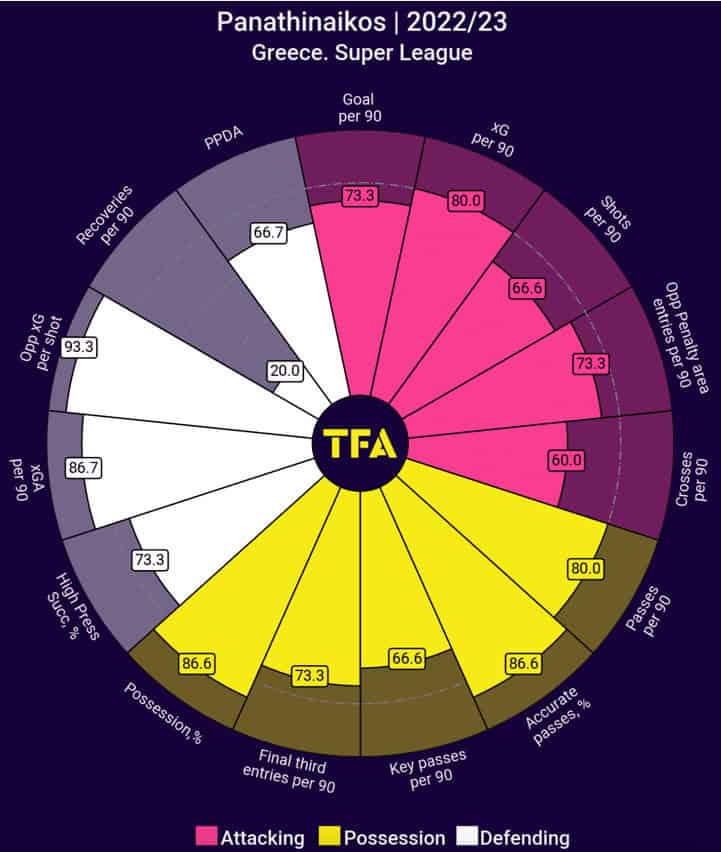
But the number that stands out this season for PAO was not the average goals conceded but the difference between the goals they should have conceded based on the quality chances of their opponents with xG against 30.73, and the goals they have conceded, 16. The difference was 14.73 in favour of PAO.
PAO was one of the strongest teams in the air, boasting an average aerial win success rate of 50.1%. The percentage was even higher for the defensive line, especially when considering only defending actions. This proficiency enabled PAO to effectively defend, when needed, in a medium or even low block, without encountering difficulties in dealing with long balls. The centre-back, Bart Schenkeveld, emerged as the top player in the league for winning aerial duels, boasting an impressive 73.79% success rate.
Before proceeding to analyse how PAO defended in certain situations, we should mention the crucial contribution of the goalkeeper Alberto Brignoli with 21 clean sheets in 36 total games (58.33%). He was probably the best goalkeeper in the league and one of the reasons that PAO managed to reach the end even without winning the title.
Structure – compactness
PAO did not have a very strict philosophy as to where they wanted to set their defensive block. Depending on the opponent, they had the collective skill to adjust the height of the defensive line from a low block to high pressing. Jovanović experimented with several formations during the season, but his core idea was to use structures with two central midfielders (over 65%). For the last 10 matches of the season in the Championship group, he used only two variations, 4-4-2 and 4-2-3-1.
The formation was usually the 4-4-2 when they stayed in a medium zone to have small distances between their lines, protect the centre of the pitch, and at the same time have enough width to defend the wide lanes.
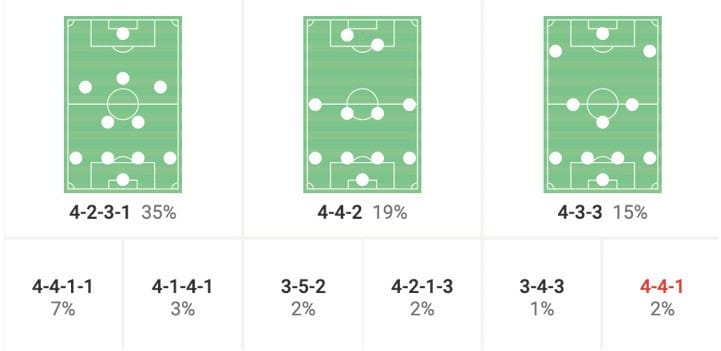
The two defensive midfielders played a significant role in maintaining compactness. Their responsibility was to push up when needed to press the opponent’s midfielders during the opposition build-up. At the same time, they were tasked with providing defensive balance and assisting the backline in winning second balls or covering the centre-backs who ventured out to defend between the lines or out wide. Additionally, the defensive midfielders were responsible for neutralising any overloaded situations in the wide areas by shifting quickly, particularly during instances of a switch in play.
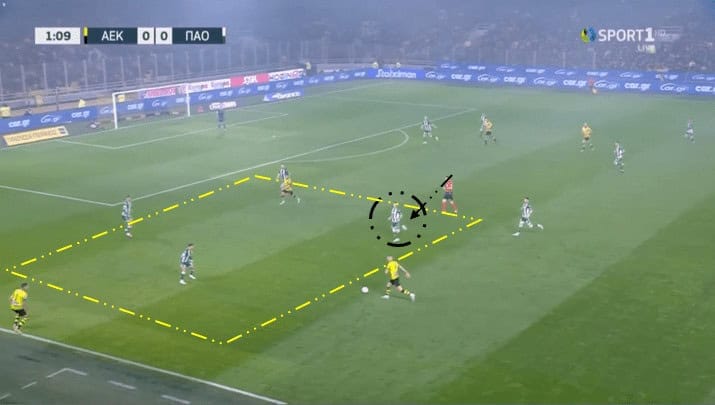
Throughout the season, Jovanović predominantly utilised three central midfielders to cover the two positions, showcasing the coach’s philosophy regarding the defensive aspect of the game. As a coach, he prefers his players to exhibit discipline, and the ability to run, fight, defend, and bring intensity to their game. Rubén Pérez, with an average of 6.19 defensive duels per game and a win rate of 60.9%, Dimitrios Kourbelis, with 7.28 and 57% respectively, and Enis Çokaj, with 5.07 and 60%, exemplify the midfield duo or trio of PAO with their resilient spirit in every match.
The centre-backs were granted the confidence and freedom to step forward or shift sideways whenever necessary to thwart any potential threats from opponents. Their speed and power, coupled with the cover provided by the two central midfielders, reinforced the defensive solidity of the team.
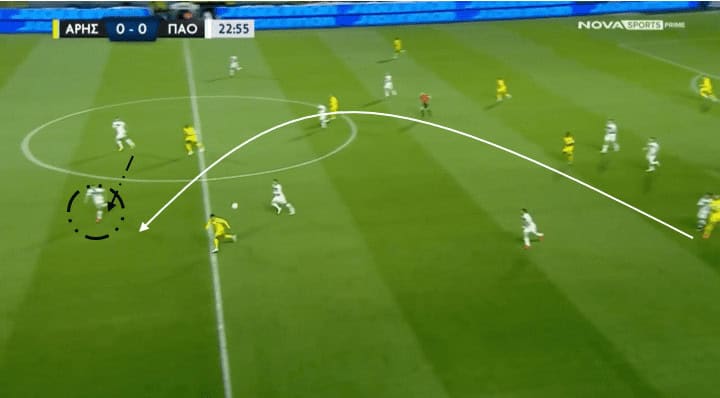
The two centre-forwards’ (usually Fotis Ioannidis, Šporar or Sebastián Palacios) primary objective was to press the on-ball centre-backs while preventing any passes to the opponent’s defensive midfielder. This was achieved either by one player closing down the ball while the other dropped diagonally to cover the passes to the number six or by executing pressing runs with curved trajectories while the other player covered the central axis. The winger on the weak side was prepared to move forward and defend if required.
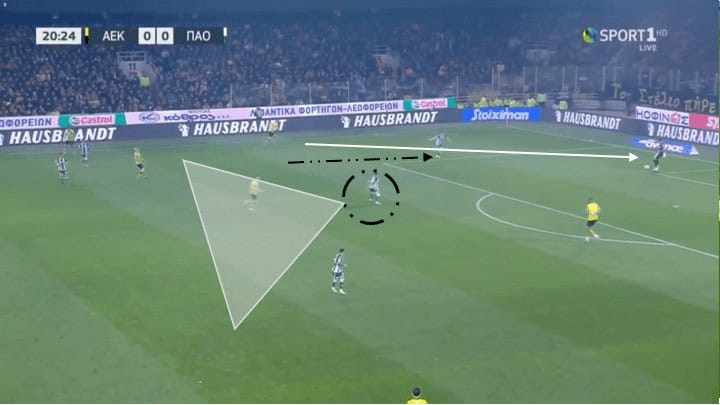
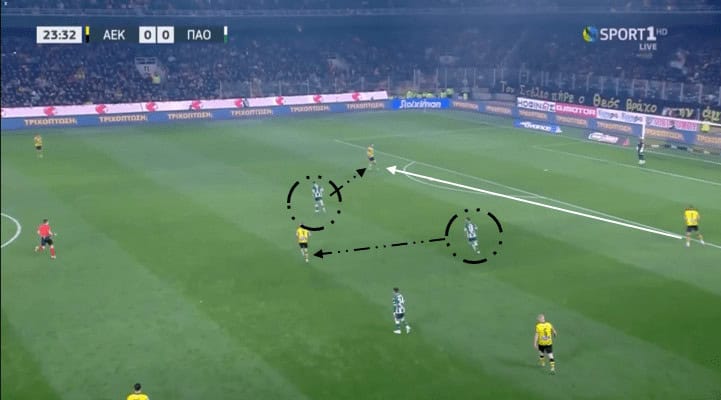
Due to these considerations, their pressing runs were not always aggressive unless they were certain that a pass to the centre was covered by the second centre-forward or a jumping-forward midfielder.
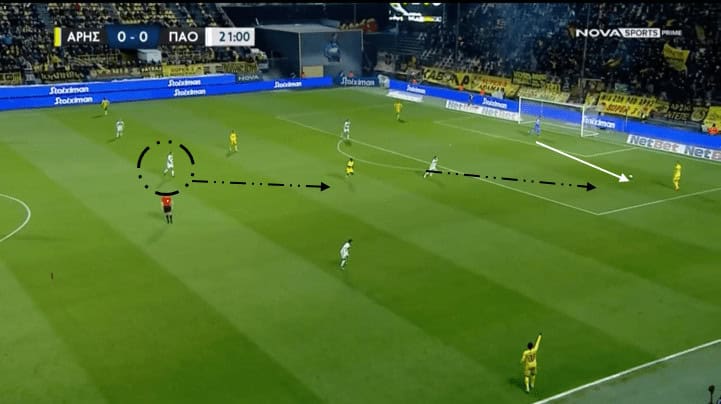
Mixing zonal and pressing defending
Ivan Jovanović’s preference for his team was the emerging trend in modern football, a combination of zonal and man-oriented pressing. By blending elements of both zonal and man-oriented pressing, PAO was able to develop a flexible defensive system that adjusted to the movements of its opponents.
Panathinaikos’ players kept their positions and pressed their opponents aggressively whenever they entered their designated zones. The primary goal was to eliminate any gaps between the defensive and midfield lines. The intensity of the pressing increased notably when the opposing team approached the halfway line, attempting to enter their half.
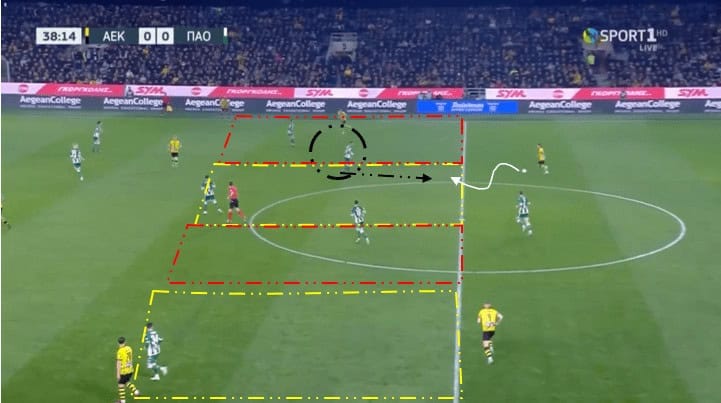
This helped to maintain defensive compactness and restrict the opposition’s options in central areas. Simultaneously, specific players may be assigned man-marking duties, focusing on pressing and applying direct pressure to their opponents when they enter those areas.
Each player had their area to protect, but if the spaces between the players and the lines were significant, there was freedom to move forward and apply more aggressive pressure following the opponent’s movements. This situation occurred when PAO pressed high, creating spaces in front of the defensive line. Consequently, the central defenders were compelled to step forward and narrow the gaps between themselves and the opponents who received the ball at their feet.
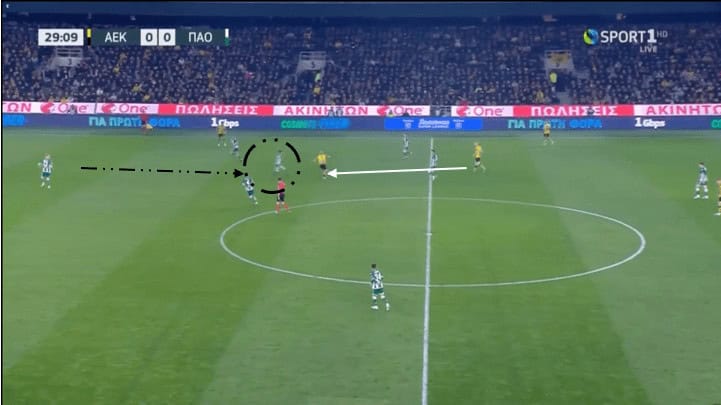
The scene below provides a clear example of how the players of Panathinaikos behaved, especially in the centre of the pitch. One of the opponents received the ball in the left central channel, prompting the left central midfielder to advance and apply pressure. Unable to progress forward, the opponent dribbles horizontally toward the right-central channel. That is a signal for the right-central midfielder to step forward. This demonstrates a zonal approach. In the same scenario, another opponent occupied the right-central channel. To avoid a numerical disadvantage of two versus one, the right winger abandons their position and presses the additional opponent from the flank.
Without a doubt, this tactic carries a certain level of risk for a quality team as it involves navigating through mixed pressure and exploiting free spaces. However, PAO chose to take a defensively proactive approach in such situations rather than remaining merely active.
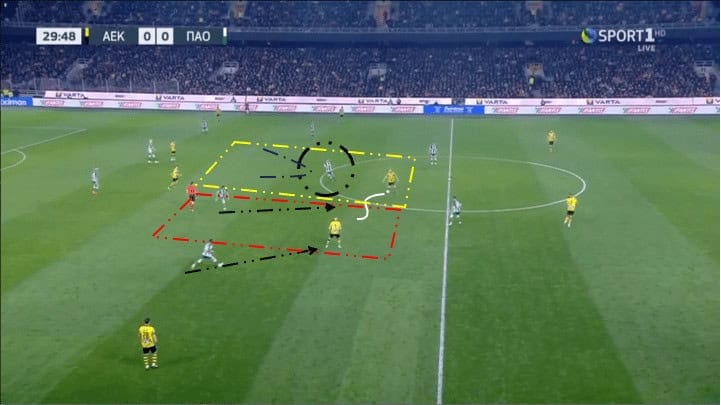
This tactical approach has certain advantages but also includes some risks. In cases when full-backs decided to step forward to press a potential receiver between the lines, a quality team with fast one-touch combinations may expose PAO’s defenders and explore spaces left behind.
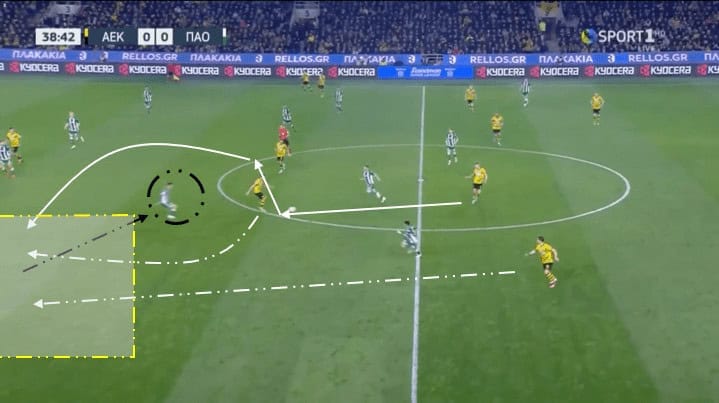
Transition to defence
Panathinaikos exhibited a highly assertive and aggressive style of play when it came to losing possession of the ball. Their core strategy revolved around the swift deployment of two, three, or even four players to pressure the ball carrier, thereby impeding the opponents’ ability to advance and escape the pressure. This aggressive pressing approach aimed to disrupt the opponents’ passing rhythm, force hurried decisions, and create turnovers in advantageous positions.
Furthermore, PAO capitalised on any opportunity to maintain the pressing intensity. Whenever the ball was passed back by the opponents, it served as a clear trigger for the team to continue their relentless pressure. This proactive approach not only limited the opponents’ time on the ball but also increased the chances of regaining possession and launching immediate counter-attacks.
However, if the opposing team managed to successfully move the ball horizontally and escape the initial pressing, Panathinaikos demonstrated tactical discipline and awareness. In such situations, when no immediate pressing option was available, the players swiftly retreated into their compact defensive structure. This disciplined defensive transition allowed them to regroup quickly, maintain defensive solidity, and deny the opponents space to exploit.
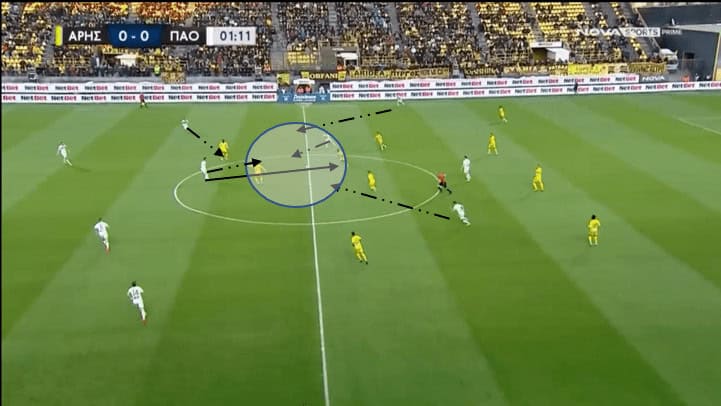
By executing these tactical movements with precision and coordination, Panathinaikos effectively disrupted their opponents’ offensive rhythm, minimised their opportunities to mount attacks, and created a sense of frustration among their adversaries. The team’s aggressive behaviour and quick defensive reactions were key elements that contributed to their defensive resilience and overall success throughout matches.
Jovanović implemented a more proactive approach for his team, reminiscent of “Gegenpressing,” also known as counter-pressing or pressing after losing possession. This defensive tactic involved PAO swiftly regaining control of the ball by immediately pressing the opponent who had just gained possession. The main objective was to deny the opponent time and space to launch an organised attack.
This pressing style required PAO’s players to have exceptional fitness, work intensely as a team, and position themselves intelligently to effectively block passing lanes and force turnovers. Additionally, PAO’s possession-based playing style during the attacking phase allowed them to have multiple players around the ball when losing it, creating opportunities for an immediate press.
Conclusion
Panathinaikos FC’s performance in the Greek Super League this season demonstrated their rebirth as one of the top teams. Led by Ivan Jovanović, they defied expectations and competed fiercely despite their limited budget. Although they fell short of winning the title, their strong defensive structure and aggressive behaviour against the ball were key factors in their success.
With a compact defensive block and a combination of zonal and man-oriented pressing, Panathinaikos effectively restricted their opponents’ options and minimised their chances. Their transition to defence was particularly impressive, with a swift and coordinated pressing effort to regain possession. The team’s dedication, disciplined approach, and exceptional fitness enabled them to implement these tactics with precision.
Through this analysis and comprehensive scout report, it is evident that Panathinaikos strategically employed their defensive strategies to disrupt the opposition’s play and maintain control.
Although they narrowly missed out on the Championship, Panathinaikos FC’s performance exemplified their renewed belief and determination to pursue their dreams.





Comments